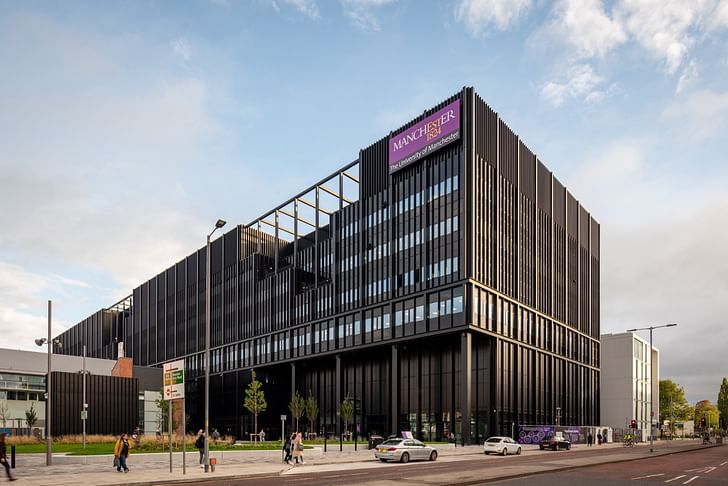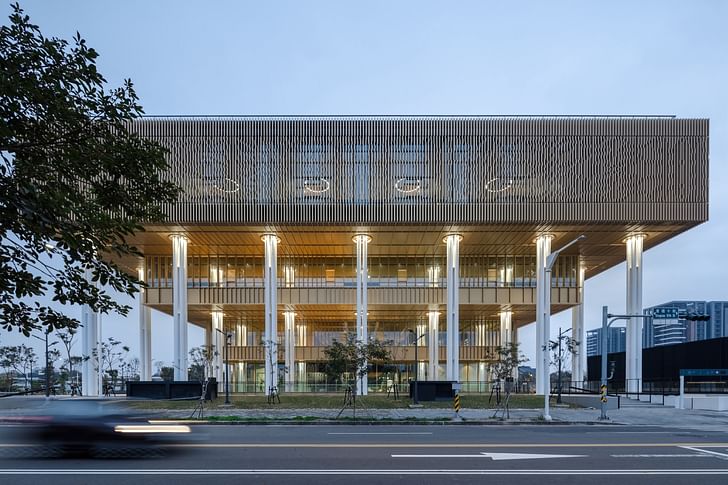

Over the past year, the number of U.S. architecture firms working on international projects has gently increased. However, a recent AIA survey found that many firms do not know how to pursue international work. In search of insights and advice on the topic, we spoke with three practices who have won acclaim for projects far beyond their base of operations: Safdie Architects, Steven Holl Architects, and Mecanoo.
Reviewing Archinect’s news coverage throughout this past summer, we can build a strong international picture of the profession. In recent weeks, New York-based PEI completed a tower in Toronto, Canada, while Massachussetts-based Safdie Architects and Rotterdam-based MVRDV both completed schemes in Shanghai, China. Elsewhere, Seoul-based Mass Studies and Minsuk Cho opened their Serpentine Pavilion in London while London-based Grimshaw completed a pedestrian bridge in Toulouse, France.
While international commissions have served a historical role in the architecture profession, recent data suggests that the number of U.S. firms pursuing international projects is gently growing in 2024. In April, the AIA’s Architecture Billings Index found that 9% of firms were currently billing for international work, up from 8% in August 2023 and 7% in February 2023. For these firms, international projects account for an average of 9.1% of gross billings.
The number of U.S. firms pursuing international work may be growing, but it is doing so from a low base and at a slow rate.
The same analysis found that, over the past five years, 14% of firms have generated billings from international projects, one-fifth of which are headquartered in the Northeast. The most popular locations for such projects are Canada (35%), Western Europe, excluding the UK (26%), Central America and the Caribbean (24%), and China (22%).
One of the more curious findings by the AIA was that 87% of firms that have worked on international projects over the past five years have no plans to work on such projects in the future. Despite turbulent business conditions across the U.S. profession, many firms told the AIA that they had sufficient levels of domestic work and did not want to deal with potential headaches on international projects, while over one-third indicated they did not know how to pursue international projects. The number of U.S. firms pursuing work outside the domestic market may be growing, but it is doing so from a low base and at a slow rate.

For Safdie Architects and Steven Holl Architects, international work is a core component of their business models. While Safdie Architects is headquartered in Somerville, MA, the practice is significantly engaged with projects across Singapore, the Middle East, and Latin America. Meanwhile, New York-based Steven Holl Architects estimates that, at any given time, 50 to 75% of their ongoing projects are located outside the United States.
“Our most effective outreach comes through publications, exhibitions, lectures, and videos on our work,” Steven Holl Architects Partner Roberto Bannura told Archinect when asked how the firm typically procures international work. “Over the years, this approach has proven to be a very effective way to attract the enthusiastic interest of like-minded clients who value the studio’s philosophy and are open to a collaborative relationship towards a shared, inspiring vision.”
“Doing good work is the best form of business development,” Safdie Architects Partner Chris Mulvey told us when asked the same question. “We’re regularly invited to consider commissions or participate in invited competitions based on our track record. Clients or advisors have visited or became aware of one of our projects and are interested in working with us or learning about how we might approach their project.”

For both Safdie Architects and Steven Holl Architects, the design process for an international project is not too dissimilar to that of a project in the United States. Safdie’s Chris Mulvey explains how each project, international and domestic, begins with an extended site visit. Among the priorities are studying the local culture and atmosphere, meeting with local practices, and touring projects in the region.
“In this respect, our approach isn’t necessarily different, though it certainly requires more investment at the outset if you are working in a new location, much as it would if you were designing a certain typology, like a library, for the first time,” Mulvey notes.
“It may come across as a cliché, but I believe this to be true: Every project is a singular amalgamation of vision, circumstance, and individuals,” Holl’s Roberto Bannura meanwhile explains. “This applies unequivocally to projects in the USA, China, Albania, the Czech Republic, and elsewhere.”
It may come across as a cliché, but I believe this to be true: Every project is a singular amalgamation of vision, circumstance, and individuals. — Roberto Bannura, Steven Holl Architects
One area where international projects can depart from domestic schemes, however, is the need to collaborate with local firms in the subject country. Here, both Bannura and Mulvey outline their respective firms’ processes for searching and agreeing on a firm to collaborate with.
“How we discover suitable partners depends largely on the characteristics of a given project,” Bannura explains. “But in general terms, besides looking at their track record and the typologies and complexity of the work they have accomplished, we are always keen on knowing who they are, as a firm and as individuals: What have they done for their communities? Do they value social engagement, public space, sustainability?”

A similar process is at play at Safdie Architects. “We curate a short list of potential firms,” Mulvey explains, “based on input from the client, and from consultants and our peers working in the region who we believe can add value to the process and the project, and who can work with us to ensure the integrity of the design intent is maintained through the life of the project.”
As noted earlier, Holl and Safdie are among the 9% of U.S.-based practices that are currently engaged with international work. While this 9% figure may seem small in a profession often assumed to be highly globalized, the UK and EU show similar trends. For firms with UK office revenue greater than £30 million ($40 million USD), 71% of UK revenue is from overseas projects, according to RIBA data. For firms below that £30 million revenue, the proportion of revenue from overseas projects drops to just 9%. The Architects’ Journal has separately found that 65 of the UK’s top 100 practices are engaged in international projects.
We actively participate in tenders to expand our international portfolio, ensuring we remain competitive and open to new opportunities in various regions. — Nuno Fontarra, Mecanoo
Architecture firms in mainland Europe appear even less engaged with international work, despite the EU operating a single market for services, goods, and movement. A 2020 report by the Architects’ Council of Europe found that only 3% of work undertaken by European firms is from outside their own country.
One notable exception is Mecanoo, headquartered in the Dutch city of Delft. Approximately 65% of Mecanoo’s work is international and, while the firm operates offices across New York, London, Kaohsiung, and Abu Dhabi, much of the practice’s creative work is managed from their Delft headquarters.
“We typically secure international work through direct invitations from clients who appreciate and recognize the value of Mecanoo’s architectural approach,” Mecanoo Partner Nuno Fontarra told Archinect. “Additionally, we actively participate in tenders to expand our international portfolio, ensuring we remain competitive and open to new opportunities in various regions.”

Fontarra explained how Mecanoo approaches international projects by immersing themselves in local cultures and regulations. While recognizing that both domestic and international projects are context-sensitive, Mecanoo sees international projects as amplifying the need for the firm to embrace differing regulations, cultural contexts, and site-specific challenges. Like their colleagues at Holl and Safdie, Mecanoo places a particular emphasis on collaborating with local firms.
My advice is to embrace challenges head-on, regardless of the project’s size or complexity. — Nuno Fontarra, Mecanoo
“Collaboration with local firms is a cornerstone of our international work strategy,” Fontarra told us. “Depending on the project, these partnerships vary in scope — from acting as the architect of record, guiding us through local regulations and licensing, to co-executing the project as equal partners. This collaborative approach ensures that our designs are feasible, culturally appropriate, and aligned with local expectations and regulations.”
Cognizant of the one-third of practices who told the AIA they were unsure how to approach international projects, we asked all three firms to offer advice to their colleagues.
“My advice is to embrace challenges head-on, regardless of the project’s size or complexity,” Mecanoo’s Fontarra shared with us. “At Mecanoo, we never underestimate any project or client, understanding that each presents unique challenges. This mindset has been pivotal in our growth, as it drives us to innovate and excel, ensuring that we continue to thrive in the international arena.”

Back on the East Coast, meanwhile, both Safdie Architects and Steven Holl Architects emphasized the importance of articulating a firm’s values and building a trusting team.
“The team of collaborators and specialists becomes more important when you are working in new territory or on a new project type,” Safdie’s Chris Mulvey advises other firms. “Try to assemble a team with whom you have built mutual trust and can develop a shared language, and who can add intrinsic value (and local knowledge) to the assignment.”
Look for an exceptional site, an adequate budget, and an interesting program. Most importantly, choose your client discerningly. — Chris Mulvey, Safdie Architects
“In certain regions and at certain times, opportunities can be abundant,” Mulvey added. “Be very selective of which projects to take on — not only must they be interesting, challenging, and aligned with your values, but the parameters and means of engagement must be conducive to doing something special. Look for an exceptional site, an adequate budget, and an interesting program. Most importantly, choose your client discerningly.”
“Place yourself in the decision maker’s shoes,” Holl’s Roberto Bannura meanwhile noted. “Why would they want to engage your firm over the great local talent and reputable firms? If you stand for something greater, beyond profitable architecture-as-a-service, your work and values should speak for themselves.”
Niall Patrick Walsh is an architect and journalist, living in Belfast, Ireland. He writes feature articles for Archinect and leads the Archinect In-Depth series. He is also a licensed architect in the UK and Ireland, having previously worked at BDP, one of the largest design + ...
No Comments
Block this user
Are you sure you want to block this user and hide all related comments throughout the site?
Archinect
This is your first comment on Archinect. Your comment will be visible once approved.